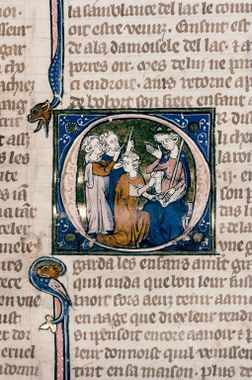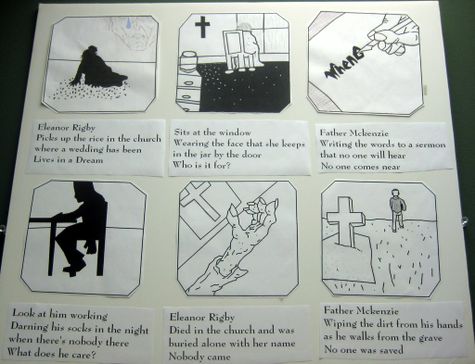Illuminated Poetry
For the next week you and a partner will be illuminating a poem or short prose piece by expressing the tone, metaphor, and imagery of the work visually. As you read over the assignment, be thinking about what works have spoken to you in the past, or speak to your teacher or librarian for recommendations. A few resources at the bottom of the page are offered for inspiration as well. By Friday you will create a single, 10" x 15" page combining the text of the original work and your art.
Suggested steps to take:
- Read the brief history below, clicking through to resources and taking note of arrangement and techniques.
- Look at the contemporary and student examples below to get a clear vision of what is expected.
- Look to the list of poems and authors below and find a short piece that speaks to both of you. If you want to choose one not on the list, go for it! Have your list narrowed down to 1–3 by end of the hour Monday.
- Read over the work together. Most poems are meant to be heard, so don't be shy about reading to one another!
- As a pair, complete the TP-CASTT Worksheet over the work. This should be completed by the end of the hour on Tuesday.
- Google some names from the artist list below, and seek out illustrated/graphic works from the library for inspiration. You may use any medium you would like. Original photography, line drawing, Photoshop/Inkscape/digital artwork, pen and ink, watercolor, calligraphy, pastels among many others are all acceptable. Play to your strengths and don't be afraid to divide up the work.
- A rough sketch of your ideas should be turned in before you begin the final draft.
- The final draft should be at least 10" x 15" on an 11" x 17" sheet of paper, due Friday. We will scan them in the end, so you may email a digital file in lieu of a physical copy.
History
Making copies of a written work took much time and effort before the invention of the printing press. Before then, each page of a book was handwritten by scribes or monks. Particularly important works for the church or wealthy patrons were illuminated with bright colors and gold leaf. The page to the right is from The Romance of Lancelot du Lac, written in France around 1300.[1] The page might look like an ancient children’s book, complete with illustrations. This is appropriate because both words (“illuminate” and “illustrate”) come from the Latin illustrationem, meaning “vivid representation.”[2] Other impressive historic examples include the Book of Kells and William Blake's illustrations from his books of poetry.
Examples
Contemporary
These frames come from Craig Thompson’s graphic novel Blankets.
The panel on the left expands upon the metaphor “to burn my memories” by actually representing the character becoming enflamed.
The panel on the right is close to a classic illuminated page in that the words are represented in the picture; the words are illuminated by the corresponding image.
Both approaches use the combination of text and images to create a stronger thematic understanding in the audience.
Student work
In this example (done on posterboard rather than paper), the student has interpreted the tone of "Eleanor Rigby" by The Beatles through stark, black and white digital art. Each frame illuminates a particular stanza from the song, expanding the reader's understanding (and possibly enjoyment) of the work.
Resources
How to lay out a comic page like a pro
Comic/Graphic Artists
Add to this list if you find some great artists!
- Craig Thompson
- Chris Ware
- Ivan Brunetti
- Boulet
- Jim Woodring
- Alison Bechdel
- Megan Kelso
- Gabrielle Bell
- David Mazzucchelli
- Roz Chast
Comic Resources
- Billy Ireland Cartoon Library & Museum
- The Digital Comics Museum
- Comics Art Museum
- Acme Novelty Library
- William Blake's illuminations
- British Library's Tour of Illuminated Manuscripts
- Book of Kells
- Craig Thompson image search
Literary Resources
- Guilt by John Betjeman
- The Tyger by William Blake
- When Earth's Last Picture is Painted by Rudyard Kipling
- Mirage by Christina Rossetti
- Karma Police by Radiohead
- Paradise Lost by John Milton
- Flash (very short!) contemporary fiction
- Add to the list as you find more resources!
References



